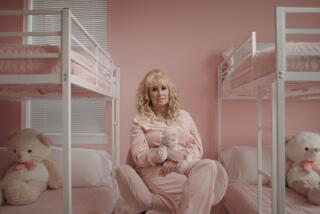Review: âGundaâ proves to be a wordlessly sublime slice of porcine life down on the farm
The Times is committed to reviewing theatrical film releases during the COVID-19 pandemic. Because moviegoing carries risks during this time, we remind readers to follow health and safety guidelines as outlined by the Centers for Disease Control and Prevention and local health officials.
If it has felt to you, these past months, like life has become very small and circumscribed, the most relatable movie character of 2021 may not be a person, but a pig. âGunda,â the star of Victor Kossakovskyâs gorgeous, wordless, black-and-white documentary, is a put-upon mother, an exhausted caregiver, an impatient teacher, and a sow. And though she is, like so many of us, confined to quarters, she is our unwitting access to 93 minutes of sedate yet spectacular, snout-level action that can only be described as the porcine sublime.
As a farmyard pig who has just had a litter, Gunda has a tag through her ear and a hungry, needy little mouth clamped to every teat. Her offspring, so newborn they donât yet seem to know where they end and their mother, each other and the world begins, scramble blindly over one another to get at her milk. Eventually, sated, they pile up into one drowsy, fluffy snowdrift of white piglet. No human has intervened, and none shall be so much as glimpsed throughout. But evidence of human interference and domestication abounds, in the tagged ear, the wire fencing, the loose slats of Gundaâs shelter, and, ominously, the grinding gears and dirt-clotted treads of some heavy farm machinery. Underneath the birdsong and the buzzing of insects â Alexandr Dudarevâs soundscape is an irreplaceable part of the filmâs immersive, almost Sensurround effect â there is the rumble of far-off traffic.
Already during the lengthy opening, weâre met with the compelling contrast in Kossakovskyâs approach â between the minutely patient watchfulness of his and co-DP Egil HĂĽskjold Larsenâs camera and the sensation of erratic, unpredictable life teeming and humming all around. The high-contrast, hyperreal monochrome images are strikingly, almost impossibly formal at times, and Gunda herself can work a rim-light halo better than Marlene Dietrich. But sound and movement and dappled sunlight also crowd the frame, giving even the noblest portrait of this stoic matriarch a vivid spontaneity. Like Gunda, who knows no other way of being, âGundaâ lives in the passing moment.
The piglets grow bigger as months go by. Sometimes they are inside the shed â mama likes to nap with her snout sticking through the doorway, sniffing the sunshine. Sometimes they are out in the yard roughhousing or rootling through the underbrush in a nearby field, while Gunda has a little me-time wallow, in mud that turns her bristly, pale flank dark and slick as a hippoâs. One particularly eventful day sees a piglet get lost in a pile of straw, only to eventually find its way out, and no offense to George Bernard Shaw, but the maxim that there can be no drama without conflict has never felt more false. âGundaâ is full of little stories like this, conflict-free but uncannily engrossing anyway.
There are supporting characters too, who occasionally upstage their top-billed costars. An intrepid, one-legged chicken overcomes its disability and the obstacle of a fallen log, and is rewarded with the filmâs most overtly heroic shot as it pivots delicately, like a ballerina en pointe, framed by a dead tree that arches overhead like a proscenium. A herd of glossy Friesian cattle canters in majestic slow motion out from a barn into a misty morning field. Later, in the midday heat, the cows stand in top-to-tail pairs helpfully swishing the nuisance flies off each othersâ faces â once you notice and realize this detail it is, again, oddly thrilling. Perhaps conflict is only necessary for human dramatics; for animals, to be alive is drama enough.
Natalie Portman hasnât eaten meat since she was nine years old.
Certainly Gundaâs days, though theyâre mostly spent suckling, snoozing or snuffling, seem full to bursting with the business of getting on with things, punctuated with periods of lazy contentment or high comedy. Thereâs something inherently hilarious about a high-stepping chicken fastidiously shaking a claw free of twigs. And Gunda looking on while, primly out of focus in the foreground, one of her piglets forcefully urinates â for a comically long time for so little a creature â is as pure an impromptu sight gag as youâll find.
The chickens never meet the pigs. The pigs never meet the cows. The elegance of Kossakovskyâs construction of this little world conceals the fact that he shot it on several farms in Norway, Britain and Spain. But to know this and other secrets of the filmâs production â like that the dappled light effect comes courtesy of a mirror ball, or that those intimate interior shots required the construction of a camera-rig-friendly version of Gundaâs little domain â cannot detract from its achievement. Kossakovsky, who did much the same thing with his last film, âAquarela,â only on a scale as massive as âGundaâ is minute, has had to invent a new kind of cinematic language to describe animals and their interior lives without having them interact with humans and without ascribing human traits and emotions to them. And the shimmering result is that we feel empathy for Gunda not because she is like us, not because she looks happy or sad or Insta-ready or occasionally a bit like Larry David just before the âCurbâ music plays, but because we are like her. We donât need to map Gundaâs reactions onto the planes of the human experience, because we can see that our true natures, so deeply buried beneath layers of socialization, civilization and sophistication, spring from exactly the same, animal place as hers. Kossakovsky doesnât anthropomorphize the animals; if anything, he zoomorphizes us.
This wholesale invention of a new, glisteningly real way of looking at the animal world makes âGunda,â which is executive produced by noted vegan Joaquin Phoenix, much more than a manifesto for vegetarianism, although the plaintive, poignant ending can certainly be leveraged to that agenda. Beyond its value as a meditation on animal captivity and cruelty, and its implicit insistence on an ethical reevaluation of our relationship to livestock, this is a film that pays attention to things weâve long neglected and to in-between interludes we have forgotten how to see. There can be a peculiar power in the round, alarmed eye of a chicken, and there can be drama in the darting tongue of a piglet catching raindrops during a shower; even our empty moments â and there have been so many of those recently â can be full of life.
'Gunda'
Rated: G
Running time: 1 hour, 33 minutes
Playing: Starts April 16, The Landmark, West L.A.; Laemmle Playhouse 7, Pasadena; and in limited release where theaters are open
More to Read
Only good movies
Get the Indie Focus newsletter, Mark Olsen's weekly guide to the world of cinema.
You may occasionally receive promotional content from the Los Angeles Times.











